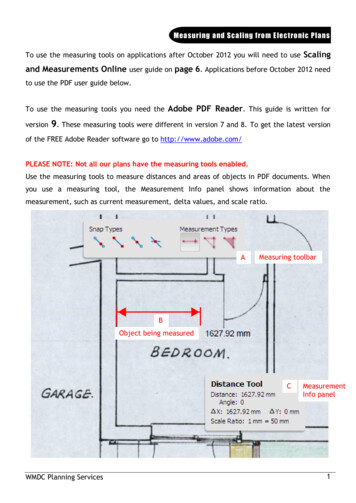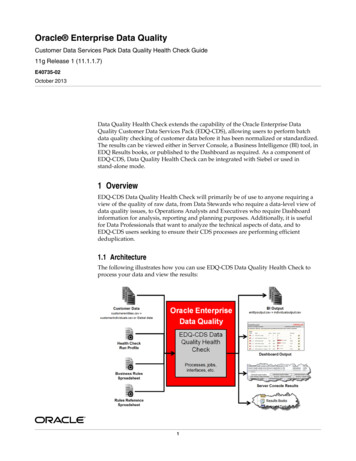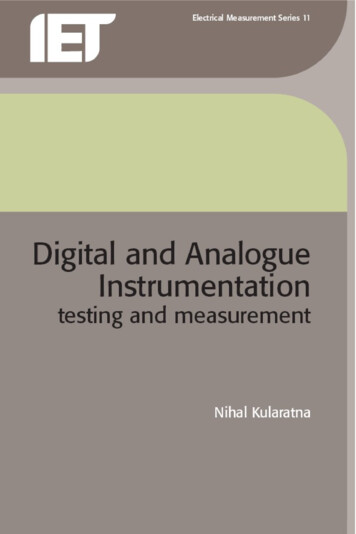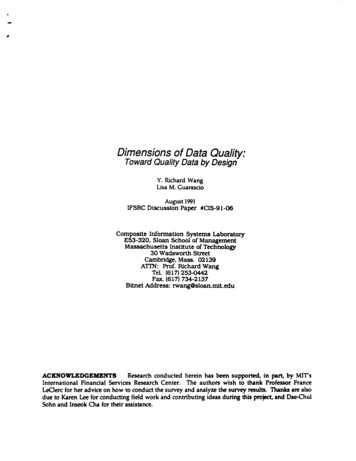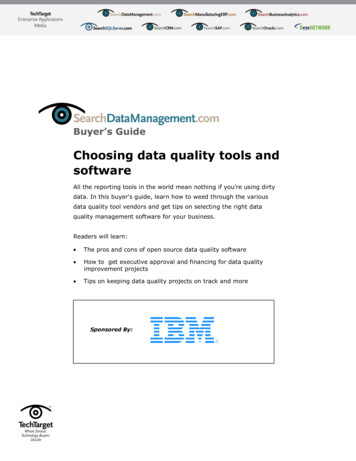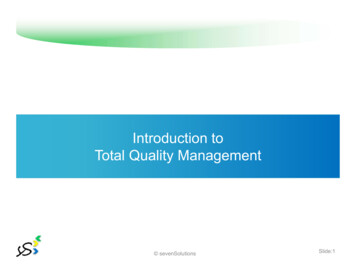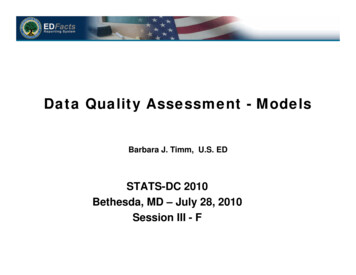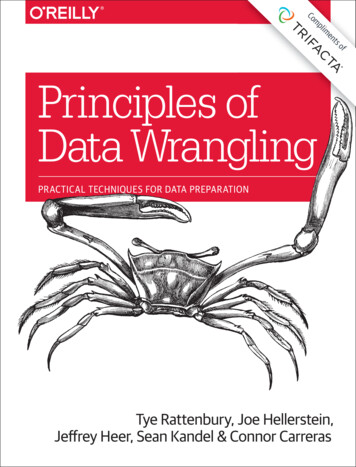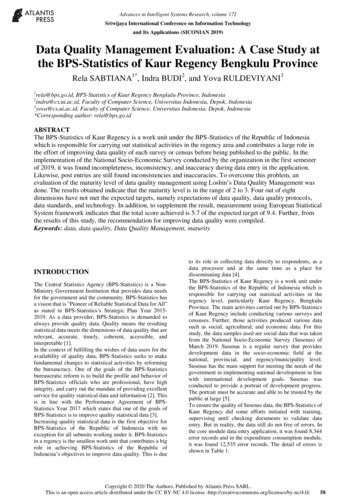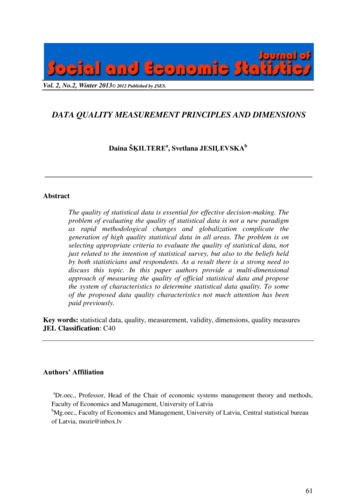
Transcription
Vol. 2, No.2, Winter 2013 2012 Published by JSES.DATA QUALITY MEASUREMENT PRINCIPLES AND DIMENSIONSDaina ŠĶILTEREa, Svetlana JESIĻEVSKAbAbstractThe quality of statistical data is essential for effective decision-making. Theproblem of evaluating the quality of statistical data is not a new paradigmas rapid methodological changes and globalization complicate thegeneration of high quality statistical data in all areas. The problem is onselecting appropriate criteria to evaluate the quality of statistical data, notjust related to the intention of statistical survey, but also to the beliefs heldby both statisticians and respondents. As a result there is a strong need todiscuss this topic. In this paper authors provide a multi-dimensionalapproach of measuring the quality of official statistical data and proposethe system of characteristics to determine statistical data quality. To someof the proposed data quality characteristics not much attention has beenpaid previously.Key words: statistical data, quality, measurement, validity, dimensions, quality measuresJEL Classification: C40Authors’ AffiliationaDr.oec., Professor, Head of the Chair of economic systems management theory and methods,Faculty of Economics and Management, University of LatviabMg.oec., Faculty of Economics and Management, University of Latvia, Central statistical bureauof Latvia, mozir@inbox.lv61
Daina ŠĶILTERE, Svetlana JESIĻEVSKA - DATA QUALITY MEASUREMENT PRINCIPLES AND DIMENSIONS1. IntroductionSince all types of research must respond to the agreed canons of quality (Marshall andRossman 2006), we cannot avoid discussing them, in spite of their philosophical and practicalcomplexity as well as the difficulty in defining what quality actually means or covers.Nowadays there are multiple different ways to define data quality and there is currently nocommonly agreed definition on what data quality is. Different analysts and different agenciesprovide different answers (Brackstone 1999, Carson 2000, Pipino et al. 2002), but all agreethat “data quality” is a multidimensional concept.In this paper authors provide multi-dimensional approach of measuring the quality ofofficial statistical data and propose the system of characteristics to determine statistical dataquality.2. Data quality overviewConfidence in the quality of the statistical data is a survival issue for a statistical office. Ifits information becomes distrustful, the reputation of the statistical office is called intoquestion. But quality is not an easily defined concept, and has become an over-used term inrecent years.There are multiple different ways to define data quality and there is until now there is nocommonly agreed definition on what data quality is. As an example, Wang and Strong (Wangand Strong,1996) define that qualitative data should fit for use by data consumers. Kahn,Strong, and Wang (Kahn, Strong, and Wang,2002) give define data quality as "conformanceto specifications" and "meeting or exceeding consumer expectations". Redman (Redman2001) suggests that data of high quality should fit for their intended uses in operations,decision making, and planning. One more aspect here is that data are free of defects andpossess desired features.A popular definition for quality is fitness for use provided by Juran(Juran, 1974). Therefore, the interpretation of the quality of some data item depends on theneeds of data users and the tasks this statistical data should serve. While one user mayconsider the data quality sufficient for a given task, it may not be sufficient for another taskor another data user.One positive aspect in the problem of defining data quality is that we recognize itsimportance (Dörnyei, 2007), at the same time unfortunately there is no guideline to auniversally accepted convention in judging quality (Denscombe, 2003). In fact, there arevarious very general dimensions of data quality. These dimensions define the characteristicsof data in measurable forms. A data quality dimension is defined as a set of data qualityattributes that most data consumers react to in a pretty consistent manner (Wang, Ziad andLee, 2001). The most commonly mentioned data quality characteristics from scientificliterature summarized by authors are the following (see Table 1):62
Daina ŠĶILTERE, Svetlana JESIĻEVSKA - DATA QUALITY MEASUREMENT PRINCIPLES AND DIMENSIONSTable 1.Data Quality characteristicsData thinessValidityDefinitions from the literatureLee et al. defined as the ease and breadth of access to information (Lee et al. 2001).Blackstone commented that the accuracy of statistical data requires that it is accessible,interpretable, coherent (Blackstone 2001).As Sandelowski (Sandelowski 1986) explained, generalization is a very broad conceptas every research situation is made up of a particular researcher in a particularinteraction with particular informants.Guba (Guba 1981) refers to fittingness, or transferability, as the criterion against whichapplicability of qualitative data is assessed.Authenticity deals with an obligation to improve the respondents‟ abilities toexperience, understand andact in their reality.According to Vaismoradi and Salsali coherence describes the fit between the aim, thephilosophical perspective, the researcher role in the study and the methods ofinvestigation, analysis and evaluation undertaken by the researcher (Vaismoradi andSalsali 2010).Confirmability means that conclusions, interpretations and recommendations should betraced back to their sources (Erlandson et al. 1993).Credibility deals with the focus of the research and means the level of confidence inhow well data and processes of analysis address the intended focus (Polit and Hungler1999).According to Cornick, credibility relates to the degree to which data can be believedbased on the ability of the researcher (Cornick 2006).Neutrality is the freedom from bias in the research procedures and results (Sandelowski1986).Guba (Guba 1981) defines neutrality not as researcher objectivity but as data andinterpretational confirmability.Being objective means not to be influenced by personal feelings or opinion and not tobe dependent on the mind for existence (Soanes and Stevenson 2003).Reflexivity means the capacity to reflect upon one‟s actions and values when producingdata (Seale 1998, Gouldner 1972).Relevance is a key dimension as if the data does not address data users‟ needs and whenthe data user will find the data inadequate.Reliability means that data should be free from sources of measurement error andconsistent (Creswell 2002).Rigor means that data is strict and inflexible (McKean 2005).Security means keeping data secure and restricting access to it.Timeliness refers to whether data is current.Transferability means whether data can be used within other similar contexts (Houghtonet al. 2012).Trustworthiness is closely connected with validity and reliability (Seale 1999).Trustworthiness also includes the question of transferability (Polit and Hungler 1999).Trustworthiness is composed of credibility, dependability, confirmability andtransferability (Politet al. 2001).Validityrefers to whether to whether measuring instrument is measuring what it wasintended (Everitt 2002, p.388).Some quality characteristics like objectivity, security, confirmability, coherence, rigor,neutrality are not so commonly mentioned and defined. At the same time, accessibility,timeliness, accuracy, validity, reflexivity, credibility are widely discussed in the context ofdata quality.Some more data quality criteria from the literature are the following: transferability,generalizability, ontological authenticity, reciprocity, dependability, fittingness, vitality,63
Daina ŠĶILTERE, Svetlana JESIĻEVSKA - DATA QUALITY MEASUREMENT PRINCIPLES AND DIMENSIONSsacredness, goodness (Creswell 2002, Patton 2002, Spencer et al. 2003); fairness (Lincolnand Guba 2000); breadth and depth (Flick 1992); consensus, instrumental utility (Eisner1991); openness and clarity (Cohen and Crabtree 2008); verisimilitude, integrity, verite‟(Garman 1994); resonance (Tracy 2010); extrapolation, reciprocity, empathic neutrality(Patton 2002); locatability (Goodhue 1995); portability (Caby et al. 1995); appearance,comparability, precision, relevance, redundancy, context, informativeness, conciseness,importance, sufficiency, usefulness (Delone et al. 1992).Authors made the conclusion that there are many different views on defining anddetermining data quality and no systematic approach. That is why in the next chapter authorsproviding their systematic approach of determining data quality.3. The new system of data quality measurementBefore giving the systematic approach of determining statistical data quality authorsmake a distinction between three different phenomena that is data, information andknowledge. What is the difference between data, information and knowledge?Checkland and Howell (Checkland and Howell,1998) suggest that information isstructured data that has contextual meaning. Information becomes knowledge at the momentof its interpretation (Miller 2002). Nonakaand Takeuchi (Nonaka and Takeuchi 1995)understand information as a flow of messages, while knowledge is created by that very flowof information anchored in the beliefs and commitment of its holder. As a result knowledge issubstantially related to human action. Sutter suggests that good quality information shouldsatisfy criteria specified by the information user, together with a certain standard ofrequirement which depends to the use that is made of it (Sutter 1993).The authors provide the following view of the link between data, information andknowledge that is based on the definitions mentioned above (see Fig.1).Dimension 1: Data QualityAchieved data utility/ importanceDimension 2: Information qualityInformation has intentional useDimension 2: Knowledge qualityFig.1. Link between data, information and knowledge quality64
Daina ŠĶILTERE, Svetlana JESIĻEVSKA - DATA QUALITY MEASUREMENT PRINCIPLES AND DIMENSIONSThis study deals with the first dimension: data quality. Authors propose the followingsystematic approach for determining data quality that contains eleven characteristics ofquality:1. Validity reliability accuracy representativeness adequacy and substantiated nature of a measuring instrument objectivity2. Comparability3. Completeness4. Coherence5. Understandability/interpretability/clarity of the data6. Complexity7. Flexibility8. Timeliness/actuality in disseminating results9. Utility/importance10. Informativeness11. Sensitivity.These characteristics of data quality can be classified into 4 Dimensions (see Table 2).Table 2. Dimensional classification of data quality characteristics (authors’)DimensionsDimension 1: Data users related qualitycharacteristicsDimension 2: Data reporting and access relatedquality characteristicsDimension 3: Statistical process related qualitycharacteristicsDimension 4: Institutional quality characteristicsData quality clarity of the dataTimeliness/actuality in disseminating ity/importanceThe proposed components of the data quality measuring system are defined andunderstood in the following way:1) ValidityIn the scientific literature validity is a term which can be applied to a lot of phenomenon;it can apply to a complete study and even to a whole theory and all its related empiricalinvestigations. Brinberg and McGrath state that validity is like integrity, character, andquality, to be assessed in relation to aims and circumstances (Brinberg and McGrath 1985).Maxwell gives the similar idea that different methods can produce valid data in somecircumstances and invalid ones in others (Maxwell 1992).As a result, the exact nature of65
Daina ŠĶILTERE, Svetlana JESIĻEVSKA - DATA QUALITY MEASUREMENT PRINCIPLES AND DIMENSIONS„validity‟ is a highly debated topic in the context of research since there is no single or agreeddefinition of this term.Authors propose the following definition of validity: The “validity” in the context ofstatistical data quality is in correspondence with reality that is supported by theadequacy and substantiated nature of a measuring instrument. Validity implies thatstatistical data should be accurately estimated and as a result data are of high validity ifthey are reliable, representative and objective.Validity is a multi-dimensional and consistsof the following characteristics: reliability, accuracy of estimates, representativeness,adequacy and substantiated nature of a measuring instrument, objectivity. Reliability means the closeness of the initial estimated value to the subsequentestimated value. Reliability involves comparing estimates over time or in other words,reliability refers to revisions. Generally speaking, the smaller and fewer the revisions, thebetter. Accuracy of estimates refers to the closeness between the estimated value and the truevalue that the statisticians measured. In practice, there is no overall measure of accuracy.Assessing the accuracy of estimates involves evaluating the error associated with an estimate. Representativity is often used in survey research, but usually it is not clear what itmeans. Kruskal and Mosteller (Kruskal and Mosteller1979a, 1979b and 1979c) found thefollowing meanings for „representative sampling‟: (1) general acclaim for data, (2) absence ofselective forces, (3) miniature of the population, (4) typical or ideal case(s), (5) coverage ofthe population, (6) a vague term, to be made precise, (7) representative sampling as a specificsampling method, (8) as permitting good estimation, or (9) good enough for a particularpurpose. The authors agree to this approach. Adequacy and substantiated nature of a measuring instrument means the correctmethodology and the correct use of methodology. Objectivity can be understood simply as accurate, reliable, and unbiased information(Noe et al. 2003). In similar words this means whether the information was objectivelycollected.2) Comparability of statistics refers to the degree to which statistical data are comparableover space (between countries) and time (between different time periods) as well aswhether enough information is given to users to prevent any confusion when comparingstatistical data.3) Completeness means that statistical data should serve user needs as completely aspossible, taking restricted resources into account.4) Coherence between statistical data is orientated towards the comparison of differentstatistical data, which are produced in different way and for different primary uses.Coherence should be analyzed in the following aspects: data produced at differentfrequencies; other statistics in the same domain; sources and outputs; coverage ofdifferent databases; and definitions and coding used for different databases.5) Understandability/interpretability/clarity of the information reflects the ease withwhich the user may understand and properly use and analyze the data. The adequacy ofthe definitions of concepts, target populations, variables and terminology underlying the66
Daina ŠĶILTERE, Svetlana JESIĻEVSKA - DATA QUALITY MEASUREMENT PRINCIPLES AND DIMENSIONSdata largely determines their degree of understandability/interpretability/clarity of theinformation.6) Complexity shows the possible difficulties that are connected with the processing ofstatistical data, usually expressed in the terms of resource consumption.7) Flexibility refers to the data ability to be adjustable to the unique needs and to therapidly changing environment.8) Timeliness/actuality in disseminating results reflects the length of time between itsavailability and the event or phenomenon it describes, but considered in the context ofthe time period that permits the information to be of value and still acted upon.9) Informativeness is a user-centred concept for evaluating the effectiveness of a statisticaldata. Informativeness indicates the raw potential a data has of informing a data user.Informativeness is particularly valuable due to its flexibility.10) Utility/importance is the extent to which the statistical data compiled and supplied bythe statistical agency is relevant to users' needs. In assessing the degree ofutility/importance, three factors are taken into account: the analysis of main users;users' requirements, as identified by the statistical agency; and the level of users'satisfaction with the statistical information. The main difficulties in assessing relevancecome from the fact that it is not easy to find out exactly who are the main users ofcertain statistical data and that the users' requirements may vary with time.11) Sensitivity is confidence in the quality of the data and is a survival issue for a statisticalagency. If its information becomes suspect, the reputation and the credibility of theagency is called into question.4. ConclusionsIn this article authors make an overview of existing theory on data quality issue. The factthat there are so many possible definitions for the term “data quality” and plenty ofmentioned data quality indicators suggests that it is a common concept relative to theresearcher and belief system for which it stems. Based on existing theory, authors developeda system of quality indicators to be used to determine the quality of statistical data. Thissystematic approach consists of the following quality characteristics: validity, comparability,completeness, coherence, understandability/interpretability/clarity of the data, complexity,flexibility, timeliness/actuality in disseminating results, utility/importance, informativeness,sensitivity. To some of these characteristics not much attention has been paid previously, forexample, complexity, flexibility, informativeness, sensitivity.In the context of proposed data quality system, authors provide the followingunderstanding of validity: The “validity” in the context of statistical data quality is incorrespondence with reality that is supported by the adequacy and substantiated nature of ameasuring instrument. Validity implies that statistical data should be accurately estimated andas a result data are of high validity if they are reliable, representative and objective.67
Daina ŠĶILTERE, Svetlana JESIĻEVSKA - DATA QUALITY MEASUREMENT PRINCIPLES AND DIMENSIONSReferencesBlackstone, G. (2001).Managing data quality: the accuracy dimension.TheInternational Conference on Quality in Official Statistics, Stockholm, Sweden.Brackstone, G. (1999).Managing Data Quality in a Statistical Agency. SurveyMethodology, 25, pp. 139-149.Brinberg, D. and McGrath, J.E. (1985).Validity and the research process. Newburypark, CA: Sage.Caby, B.C., Pautke, R.W. and Redman, T.C.(1995).Strategies for improving dataquality.Data Quality,1(1), 4-12.Carson, C. S. (2000). What is Data Quality? A Distillation of Experience.StatisticsDepartment, International Monetary Fund.Checkland, P. and Howell, S. (1998).Information, Systems, and Information Systems –Making Sense of the Field.Chishester: John Wiley and Sons.Cohen, D. J. and Crabtree, B. F. (2008). Evaluative criteria for qualitative research inhealth care: Controversies and recommendations. Annals of Family Medicine, 6(4), 331‐339.Cornick, P. (2006). Nitric oxide education survey – use of a Delphi survey to produceguidelines for training neonatal nurses to work with inhaled nitric oxide. J. Neonatal Nurs,12(2), 62-68Creswell, J. (2002). Educational research: Planning, conducting And evaluatingquantitative and qualitative research. New Jersey: Pearson Education.Delone, W.H. and McLean, E.R. (1992). Information systems success: The quest forthe dependent variable.Information Systems Research,3(1), 60-95.Denscombe, M. (2003).The Good Research Guide (2 ed.). Berkshire: Open UniversityPress.Dörnyei, Z. (2007). Research methods in Applied Linguistics. Oxford: OxfordUniversity Press.Eisner, E. W. (1991). The enlightened eye: Qualitative inquiry and the enhancement ofeducational practice. New York: Macmillan Publishing Company.Erlandson,D.A.,Harris,E.L.,Skipper,B.L. and Allen,S.D. (1993). Doing NaturalisticInquiry.A Guide to Methods.Newbury Park: Sage.Everitt, B.S. (2002).The Cambridge Dictionary of Statistics Second Edition, CambridgeUnivesity Press.Flick, U. (1992). Triangulation revisited: Strategy of validation or alternative? Journalfor the Theory of Social Behaviour, 22(2), pp. 175-197.Garman, N. (1994). Qualitative inquiry: Meaning and menace for educationalresearchers (Keynote address). Paper presented at the Mini‐Conference: QualitativeApproaches in Educational Research, The Flinders University of South Australia.Goodhue, D.L. (1995).Understanding user evaluations of informationsystems.Management Science.41(12), 1827-1844.Gouldner, A.W. (1972).Towards a Reflexive Sociology.In: C. Seale Social ResarchMethods. London, Routledge, 381-383.Guba, E. G. (1981).Criteria for assessing the trustworthiness of naturalisticinquiries.Educational Resources Infonnation Center Annual Review Paper, 29, 75-91.68
Daina ŠĶILTERE, Svetlana JESIĻEVSKA - DATA QUALITY MEASUREMENT PRINCIPLES AND DIMENSIONSHoughton, C., Casey, D., Shaw, D., Murphy, K. (2012). Rigour in qualitative casestudyresearch.Nurse Res, 20(4), 12-7.J. Juran. (1974). The Quality Control Handbook. McGraw-Hill, New York, 3rd edition.Kruskal, W. and Mosteller, F. (1979a). Representative sampling, I: Nonscientificliterature. International Statistical Review, 47, 13–24.Kruskal, W. and Mosteller, F. (1979b). Representative sampling, II: Scientificliterature, excluding statistics. International Statistical Review, 47, 113–127.Kruskal, W. and Mosteller, F. (1979c). Representative sampling, III: the currentstatistical literature. International Statistical Review, 47, 245–265Lee, Y.W., Strong, D.M., Kahn, B.K., and Wang, R.Y. (2002). AIMQ: A methodologyfor information quality assessment. Journal of Information and Management, 40, 133-146.Lincoln, Y.S., Guba, E.(2000). Paradigmatic controversies, contradictions andemerging confluences.In: Denzin, N.K., Lincoln, Y.S. (Eds.), The Handbook of QualitativeResearch, Second ed. Sage Publications, Thousand Oaks, CA, 163–188.Marshall, C. and Rossman, G.B. (2006).Designing Qualitative Research (4 ed.).Thousand Oaks, CA: Sage.Maxwell, J. A. (1992).Understanding and validity in qualitative research.In: A. M.Huberman& M. B. Miles (Eds.), The qualitative researcher’s companion, pp. 37-64.Thousands Oaks, CA: Sage Publications (Reprinted from Harvard Education al Review. 1992,62, 3; 279-300).McKean, Erin (Ed.). (2005). The New Oxford American Dictionary (2nd ed.). Oxford:Oxford University Press.Miller, F.J.(2002). I 0 (Information has no meaning),Information Research, 8(1).Noaka, I. and Takeuchi, H.(1995).The Knowledge - Creating Company: how Japanesecompanies create the Dynamics of innovation.New York: Oxford University Press.Noe, P., Anderson, F., Shapiro, S., Tozzi, J., Hawkins, D., Wagner, W.(2003). Learningto live with the Data Quality Act.Environ Law Rev., 33, pp. 10224-10236.Patton, M. Q. (2002). Qualitative research and evaluation methods (3rded.).ThousandOaks, California: Sage Publications.Pipino, L. L., Lee, Y. W., and Wang, R. Y. (2002).Data QualityAssessment.Communications of the ACM, 45, pp. 211-218.Polit, D.F. andHungler, B.P. (1999). Nursing Research.Principles and Methods, sixthed. J.B. Lippincott Company, Philadelphia, New York, Baltimore.Polit, D., Beck, C., Hungler, B. (2001).Essentials of Nursing Research – Methods,Appraisal and Utilisation.Philadelphia: Lippincot.Redman, T. C. (2001). Data quality: the field guide. Boston: Digital Press.Sandelowski, M. (1986).The problem of rigor in quaJitative research.Advances inNursing Science,8, 27-37.Seale C. (1998). Researching Society and Culture. London: Sage.Soanes, C. and Stevenson, A. (2003).Oxford dictionary of English, Oxford, UK OxfordUniversity Press.Spencer, L., Ritchie, J., Lewis, J. and Dillon, L. (2003). Quality in qualitativeevaluation: A framework for assessing research evidence. London: National Centre for SocialResearch, Government Chief Social Researcher‟s Office, UK.69
Daina ŠĶILTERE, Svetlana JESIĻEVSKA - DATA QUALITY MEASUREMENT PRINCIPLES AND DIMENSIONSSutter, E. (1993). Maîtriser l‟information pour garantir la qualité. AFNOR.Tracy, S. J. (2010). Qualitative quality: Eight “Big‐Tent” criteria for excellentqualitative research. Qualitative Inquiry, 16(10), 837‐851.Vaismoradi, M. and Salsali, M. (2010). Coherence in qualitative research. Journal ofNursing and Midwifery, 20(70).Wang, R. Y., Ziad, M.and Lee, Y. W. (2001). Data quality. Massachusetts: KluwerAcademic Publishers.Wang, R.Y. and Strong, D.M. (1996). Beyond accuracy: What data quality means todata consumers.Journal of management Information Systems, 12(4), 5-33.70
various very general dimensions of data quality. These dimensions define the characteristics of data in measurable forms. A data quality dimension is defined as a set of data quality attributes that most data consumers react to in a pretty consistent manner (Wang, Ziad and Lee, 2001).

